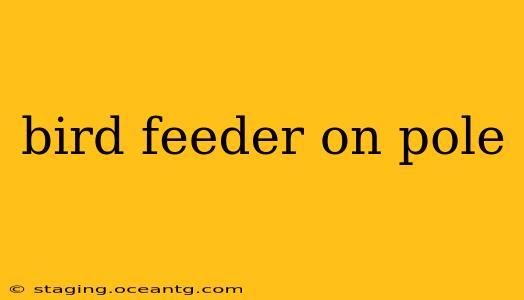Attract a vibrant array of feathered friends to your backyard with a bird feeder on a pole! This comprehensive guide explores everything you need to know, from selecting the perfect feeder and pole to ensuring its longevity and safety for your avian visitors. We'll delve into the benefits, address common concerns, and answer frequently asked questions to help you create a thriving bird-watching haven.
Why Choose a Pole-Mounted Bird Feeder?
A pole-mounted bird feeder offers several advantages over other mounting options:
- Predator Protection: Raising the feeder above ground significantly reduces the risk of ground predators like cats, raccoons, and snakes accessing the food. This ensures the safety of your feathered guests.
- Accessibility: A well-placed pole allows birds easy access to the feeder, while keeping it out of reach of unwanted visitors.
- Aesthetic Appeal: A beautifully designed pole and feeder can enhance your garden's aesthetic appeal, adding a touch of natural elegance.
- Versatility: Pole-mounted feeders accommodate various feeder types and sizes, allowing you to cater to different bird species.
- Easy Cleaning & Maintenance: The elevated position makes cleaning and refilling the feeder considerably more convenient.
What Type of Pole is Best for a Bird Feeder?
The ideal pole material depends on your budget and aesthetic preferences. Popular options include:
- Metal Poles: Durable and long-lasting, metal poles (aluminum or steel) are resistant to weathering and offer excellent stability. They can be more expensive than other options.
- Wooden Poles: Wooden poles provide a natural look and blend well with garden settings. However, they require regular treatment to prevent rot and insect infestation.
- PVC Poles: PVC poles are a cost-effective and low-maintenance alternative. They are resistant to rot, insects, and weathering, making them a practical choice.
How High Should a Bird Feeder Pole Be?
The optimal height for your bird feeder pole depends on several factors:
- Predator Presence: In areas with a high density of ground predators, a taller pole is recommended (at least 6-8 feet).
- Surrounding Vegetation: Consider the height of surrounding shrubs and trees. You want the feeder to be visible to birds but also protected from wind.
- Your Personal Preference: Choose a height that provides convenient access for refilling and cleaning the feeder, while also maximizing visibility for birdwatching. A height of 4-6 feet is often suitable.
What is the best height for a bird feeder to deter squirrels?
While no height guarantees complete squirrel deterrence, raising the feeder significantly above ground, using a pole with a squirrel baffle, or choosing a feeder with squirrel-resistant features can help deter them.
How far away should bird feeders be from windows?
Ideally, place bird feeders at least 10 feet away from windows to prevent window strikes.
How to Install a Bird Feeder on a Pole
Installing a bird feeder on a pole is a straightforward process:
- Choose a Location: Select a location away from windows, predators, and busy areas. Consider the presence of trees and shrubs that offer birds shelter.
- Prepare the Ground: Dig a hole deep enough to securely anchor the pole.
- Set the Pole: Place the pole in the hole, ensuring it's plumb (perfectly vertical).
- Secure the Pole: Fill the hole with concrete mix to secure the pole firmly in the ground. Allow the concrete to fully cure before attaching the feeder.
- Attach the Feeder: Once the concrete has set, attach your chosen bird feeder to the pole using appropriate hardware.
Maintaining Your Bird Feeder and Pole
Regular maintenance ensures the longevity of your feeder and promotes the health of your avian visitors:
- Cleaning: Clean your feeder regularly to prevent the spread of disease. Use a mild detergent and water solution, rinsing thoroughly before refilling.
- Inspection: Inspect the pole and feeder regularly for any damage or signs of wear. Repair or replace any damaged components promptly.
- Refilling: Keep the feeder consistently stocked with high-quality birdseed appropriate for the species you wish to attract.
By following these guidelines, you can successfully install and maintain a bird feeder on a pole, creating a thriving birdwatching habitat in your backyard. Remember to observe your feathered friends and adjust your setup as needed to create the perfect avian sanctuary!
